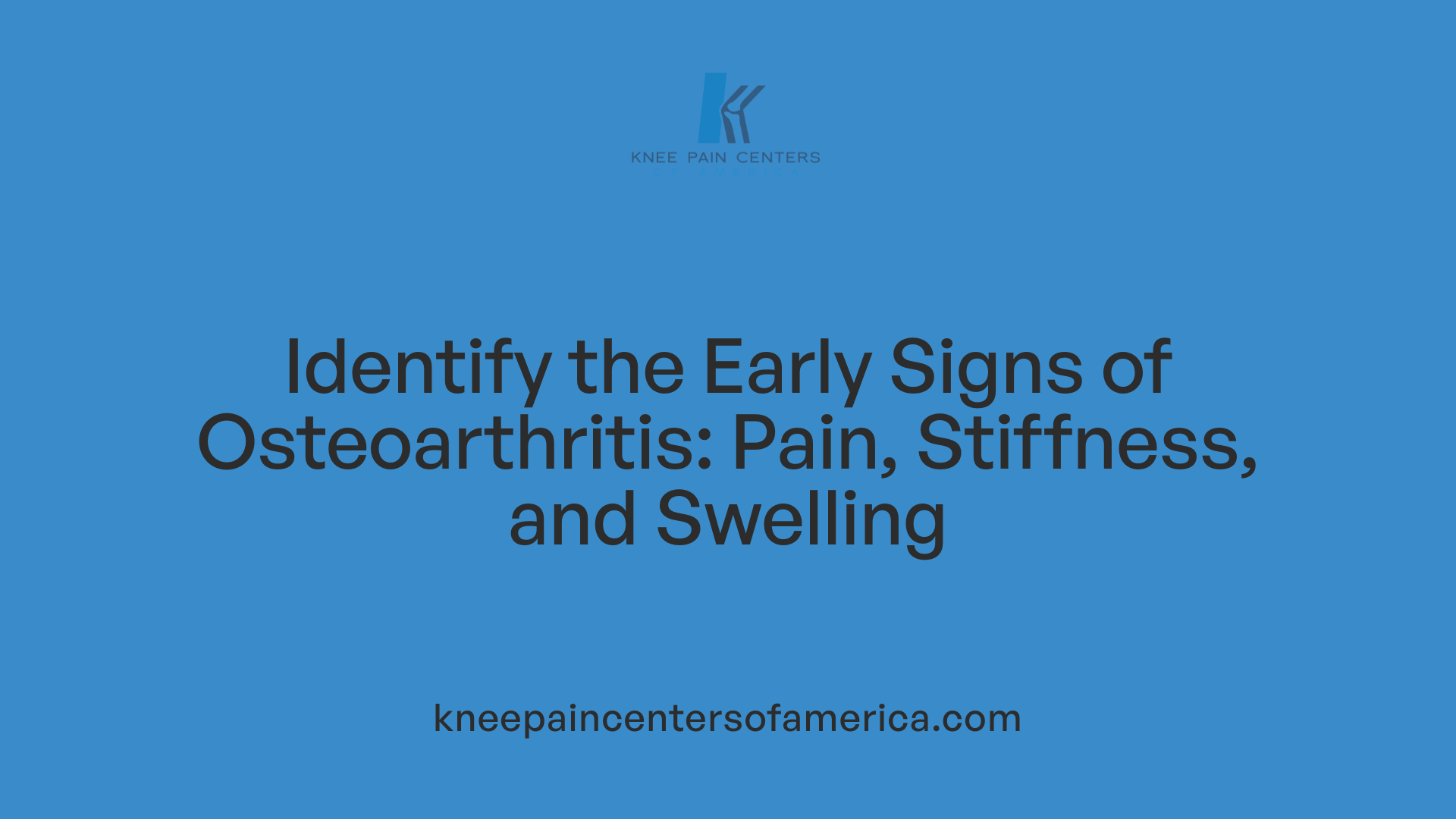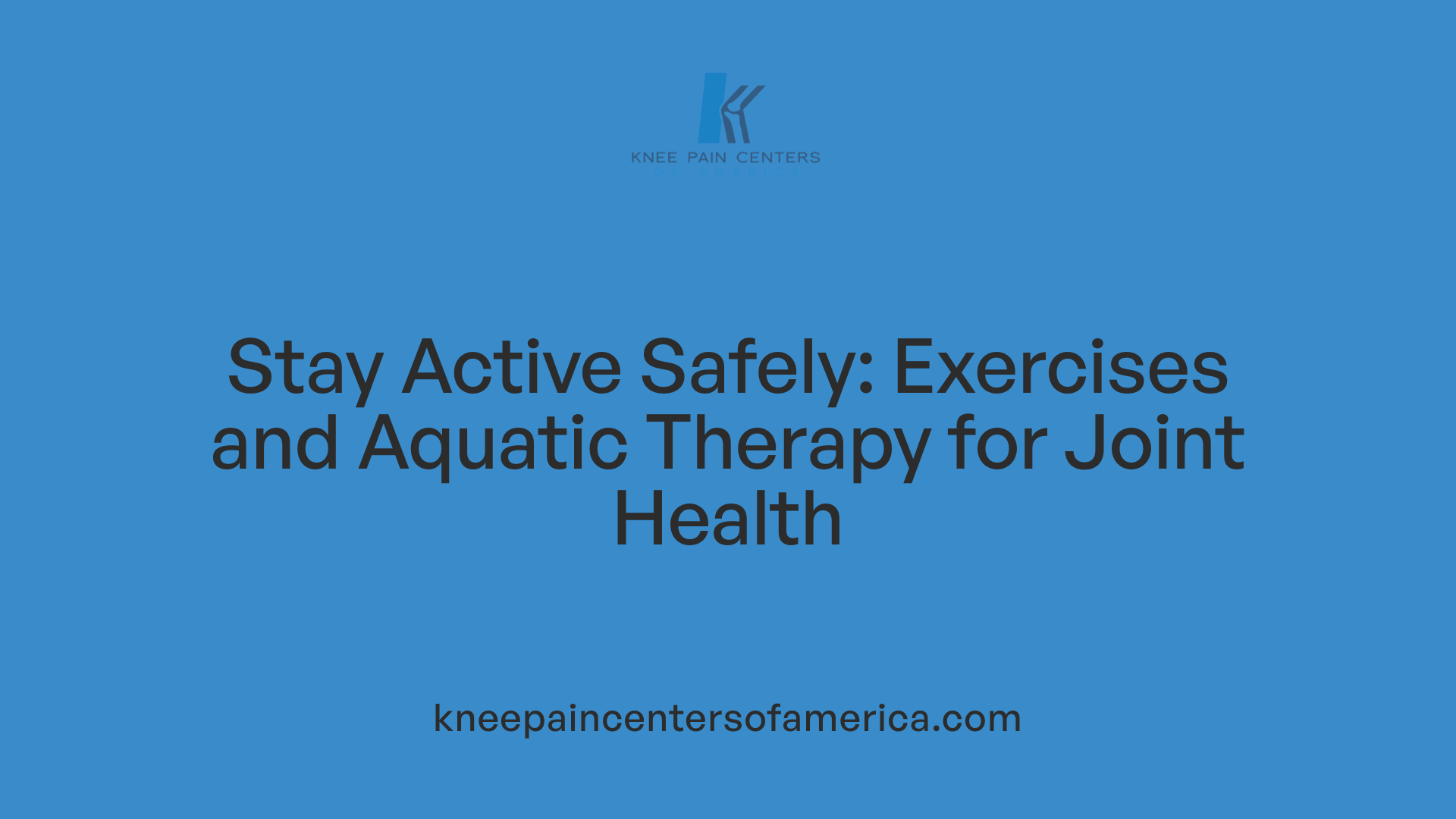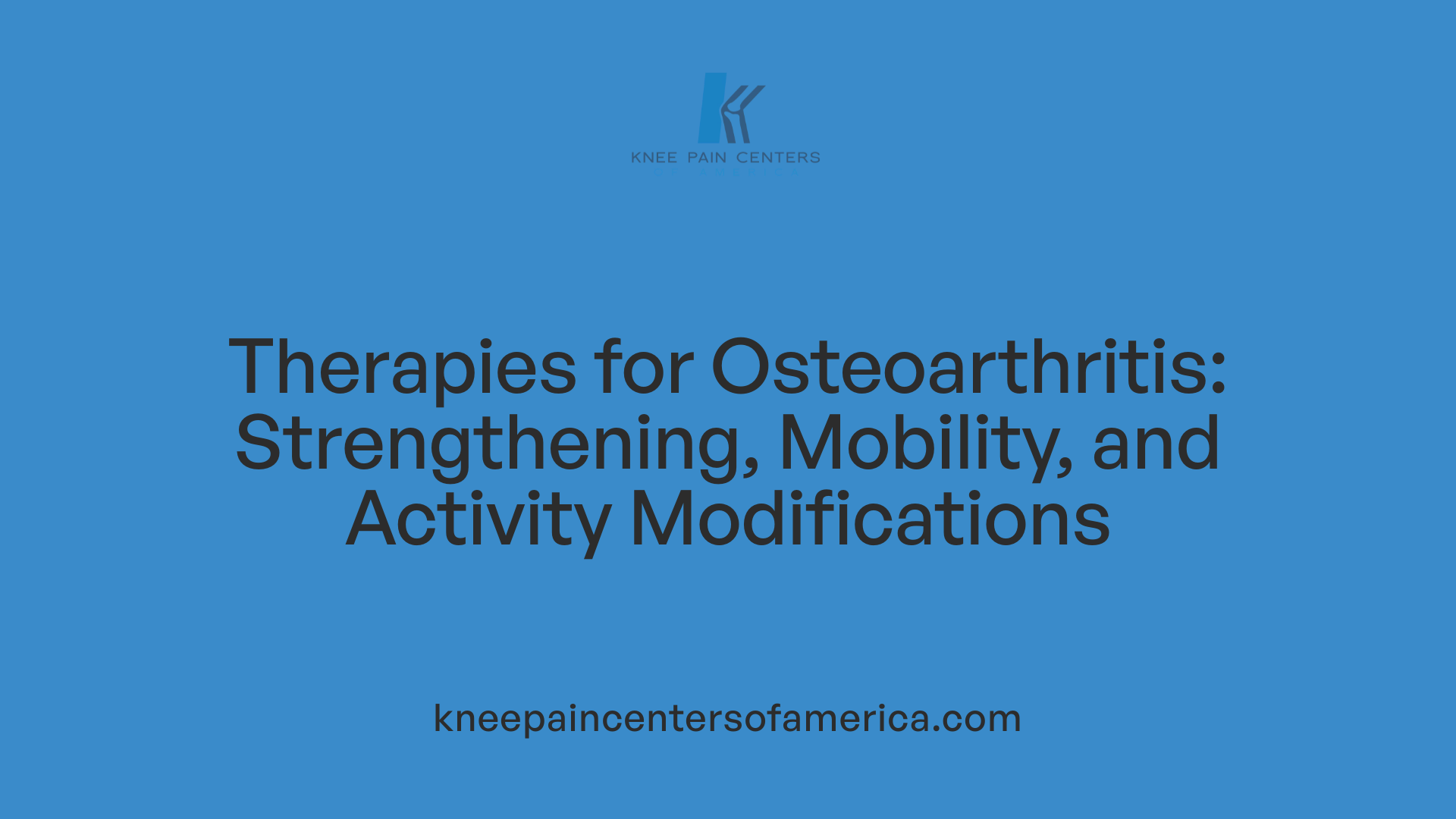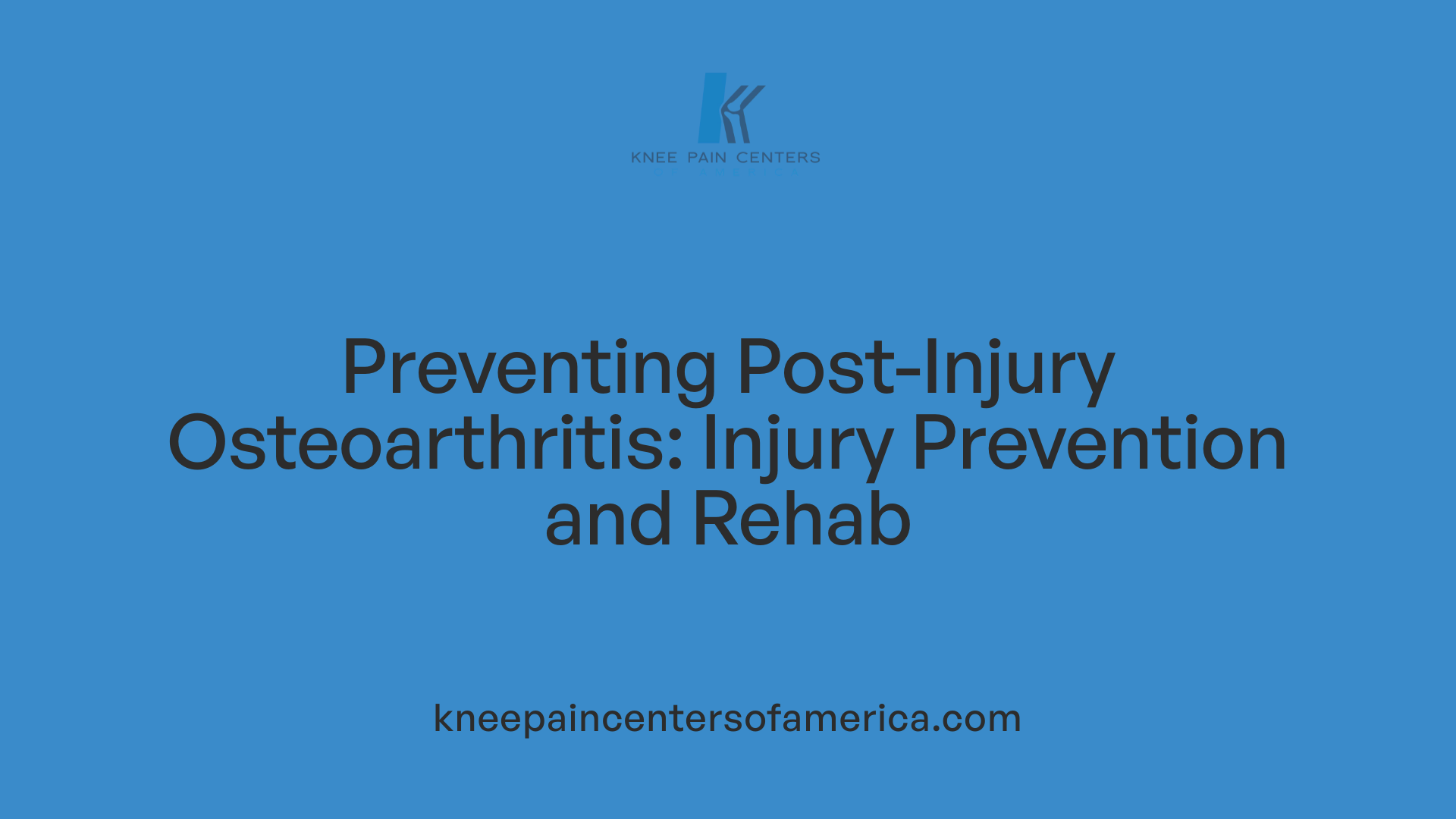Understanding Arthritis Recurrence
Arthritis, particularly osteoarthritis, is a chronic condition characterized by joint pain and stiffness that can significantly impact quality of life. While treatments are available to manage symptoms, the challenge lies in preventing arthritis symptoms from returning and worsening over time. This article explores comprehensive methods to help individuals maintain symptom relief and promote joint health through medical, lifestyle, and rehabilitative strategies.
Recognizing Osteoarthritis and Its Symptoms

What is Osteoarthritis?
Osteoarthritis is a common joint disease characterized by the gradual wear and tear of articular cartilage, leading to joint pain and reduced function. It most frequently affects the knee, especially in older adults.
What Causes Osteoarthritis?
Osteoarthritis can be classified into two types based on cause:
- Primary osteoarthritis: Occurs without a known specific reason, typically associated with the natural aging process and joint degeneration.
- Secondary osteoarthritis: Develops due to identifiable causes such as joint trauma, malformations, or other underlying joint conditions.
What are the Typical Symptoms and Progression?
Symptoms usually develop gradually and include:
- Knee pain that worsens with activity
- Joint stiffness and swelling
- Pain after periods of rest
- Progressive severity over time impacting mobility and daily function
These signs reflect the ongoing breakdown of cartilage and changes within the joint structure. Early recognition and diagnosis are important to manage symptoms effectively and slow progression.
Accurate Diagnosis as the First Step in Management

Importance of Medical History and Physical Exams
Diagnosing osteoarthritis begins with a thorough medical history and physical examination. Physicians assess symptoms such as joint pain, stiffness, swelling, and functional limitations. Understanding symptom onset and activity impact helps differentiate osteoarthritis from other joint conditions.
Imaging Tests Like X-Rays and MRI
Imaging plays a crucial role in confirming diagnosis. X-rays can reveal joint space narrowing, osteophyte formation, subchondral sclerosis, and cysts which are hallmarks of osteoarthritis. MRI offers detailed soft tissue visualization, aiding in evaluation of cartilage integrity and associated structures.
Lab Tests Including Blood and Joint Fluid Analysis
Although osteoarthritis is primarily diagnosed clinically and through imaging, laboratory tests support ruling out other causes. Blood tests exclude inflammatory arthritis or infections. Joint fluid analysis can detect crystals or infection within the joint, helping distinguish osteoarthritis from other joint disorders.
Together, these diagnostic methods establish an accurate diagnosis that guides effective treatment planning for osteoarthritis patients.
Pharmacologic Treatments to Manage and Prevent Flare-Ups

Acetaminophen for Mild Symptoms
Acetaminophen is recommended as the first-line medication for managing mild osteoarthritis symptoms due to its safety profile and effectiveness in pain relief. It can help reduce discomfort without the gastrointestinal risks often associated with other painkillers.
Use of NSAIDs for Moderate to Severe Pain
Nonsteroidal anti-inflammatory drugs (NSAIDs) are superior to acetaminophen in treating moderate to severe osteoarthritis pain. NSAIDs not only relieve pain but also help reduce inflammation around the affected joints. However, their use requires careful consideration of potential side effects, especially in patients with cardiovascular or gastrointestinal conditions.
Role of Duloxetine
Duloxetine, an antidepressant with analgesic properties, is sometimes prescribed to manage chronic osteoarthritis pain. It works by affecting nerve pathways involved in pain perception, providing an alternative for patients who cannot tolerate NSAIDs or have persistent pain despite other treatments.
Effectiveness of Intra-Articular Corticosteroid and Hyaluronic Acid Injections
Intra-articular corticosteroid injections offer short-term relief of osteoarthritis knee pain by reducing joint inflammation. They are especially useful during flare-ups but are not recommended for frequent use due to potential joint damage with repeated injections.
Hyaluronic acid injections, by contrast, tend to have less immediate effect but provide longer-term benefit in improving joint function and alleviating pain. These injections supplement the joint fluid, enhancing lubrication and potentially protecting the cartilage.
Together, these pharmacologic options form an important part of a comprehensive osteoarthritis management plan aimed at minimizing pain and improving quality of life.
Surgical Interventions When Conservative Measures Fail

When is Surgery Recommended for Osteoarthritis?
Surgical intervention for osteoarthritis typically becomes an option when conservative treatments such as medications, physical therapy, and injections fail to adequately relieve pain or improve joint function. Candidates for surgery often experience continuing pain, disability, or severe joint damage that limits daily activities despite maximal medical therapy. Early consultation with healthcare providers is crucial to evaluate the severity and explore appropriate surgical options.
Types of Surgical Procedures
Several surgical procedures are available depending on the joint involved, severity of osteoarthritis, and specific patient factors:
- Osteotomy: This procedure involves cutting and reshaping bones to relieve pressure on the affected joint. It is especially useful for younger patients with knee osteoarthritis who have joint misalignment.
- Unicompartmental (Partial) Knee Arthroplasty: Replacement of only the damaged compartment of the knee, preserving healthy bone and ligaments.
- Total Knee Arthroplasty (Joint Replacement): Complete replacement of the knee joint with prosthetic components, generally recommended for severe osteoarthritis causing significant pain and functional limitations.
- Other Procedures: Arthroscopy, lavage or debridement, and interpositional devices might be used selectively but have limited evidence supporting long-term benefits.
Benefits and Risks
Surgical interventions can greatly improve pain relief, joint function, and quality of life. Total joint replacement, for example, can restore mobility and reduce severe pain, enabling patients to return to many activities.
However, surgery carries risks including infection, blood clots, prosthesis loosening or failure, and need for revision surgery. Recovery time varies and typically involves extensive rehabilitation.
Candidates for Surgery
Ideal candidates are those with symptomatic osteoarthritis refractory to conservative treatments, significant joint damage visible on imaging, and no contraindications to surgery. Additionally, overall patient health and expectations are considered to optimize outcomes.
Proper patient selection and multidisciplinary care are essential for successful surgical management of osteoarthritis.
Self-Care Strategies to Maintain Symptom Relief

How does weight loss impact joint stress and inflammation?
Maintaining a healthy weight plays a crucial role in reducing joint stress and inflammation. Excess body weight increases pressure on weight-bearing joints, particularly the knees, accelerating osteoarthritis progression. Even a modest weight loss, such as 10 pounds, can significantly alleviate joint load and lower inflammation, easing symptoms and slowing disease advancement.
What are the benefits of gentle exercise?
Engaging in gentle, low-impact exercise like walking, tai chi, yoga, or swimming keeps joints limber and strengthens muscles that support the joints. Regular activity helps reduce pain, improves function, enhances flexibility, and delays further joint damage. Physical therapists often recommend tailored exercise programs to maintain mobility without overstraining the affected joints.
How can heat and cold therapy provide relief?
Using heat therapy, such as warm compresses or baths, relaxes muscles and increases blood flow, helping to decrease stiffness and joint pain. Conversely, cold therapy with ice packs reduces inflammation and numbness, especially after physical activity or flare-ups. Alternating between heat and cold treatments can optimize symptom control.
What role do topical analgesics play in symptom management?
Topical analgesics, including creams and gels containing nonsteroidal anti-inflammatory drugs (NSAIDs), offer localized pain relief with fewer systemic side effects. They are strongly recommended for improving function and quality of life in osteoarthritis patients.
How do assistive devices like braces and shoe inserts help?
Braces provide joint support, improve alignment, and reduce pain during movement, enhancing overall function and quality of life. Shoe inserts help redistribute pressure away from affected areas. Although lateral wedge insoles are not recommended due to insufficient evidence, other assistive devices like canes and customized braces can effectively support joint health and ease symptoms.
Importance of Maintaining a Healthy Weight and Diet

How Does Weight Management Reduce Stress on Joints?
Maintaining a healthy weight is crucial for reducing the mechanical load on weight-bearing joints such as the knees and hips. Excess body weight increases the pressure on these joints during daily activities, accelerating cartilage wear and joint degeneration. Even modest weight loss, such as 10 pounds, can reduce the risk of developing knee osteoarthritis by as much as 50%. Additionally, weight loss can ease symptoms in those already suffering from arthritis, diminishing pain and improving mobility.
What Dietary Factors Influence Inflammation?
Diet plays an influential role in modulating inflammation, a component that contributes to osteoarthritis progression. Nutrient-rich foods with anti-inflammatory properties—like fruits, vegetables, whole grains, and healthy fats—help decrease systemic inflammation. Conversely, diets high in processed foods, sugars, and saturated fats may exacerbate inflammatory conditions, negatively impacting joint health.
How Does Blood Sugar Control Affect Cartilage Health?
Proper control of blood sugar is important because elevated glucose levels can lead to cartilage stiffening and contribute to systemic inflammation. Individuals with diabetes face a higher risk of joint damage due to these metabolic changes. Managing blood sugar through diet, exercise, and medication helps protect cartilage and reduce the inflammatory processes associated with osteoarthritis.
What Is the Role of Omega-3 Fatty Acids in Joint Health?
Omega-3 fatty acids, found in fish oil and certain plant sources, have been shown to possess anti-inflammatory properties that may benefit joint health. Some studies suggest that omega-3 supplementation can reduce joint pain and improve function in osteoarthritis patients. However, they should be used under the guidance of healthcare providers as part of a comprehensive management plan.
In summary, a combination of maintaining a healthy weight and adopting an anti-inflammatory diet that supports blood sugar control is vital for managing and potentially preventing osteoarthritis. Incorporating omega-3 fatty acids adds further benefit in reducing inflammation and promoting joint wellness.
Engaging in Regular Physical Activity Safely

What Exercises Are Recommended for People With Osteoarthritis?
For individuals living with osteoarthritis, gentle and moderate exercises such as walking and gardening are highly encouraged. These activities help keep joints flexible, strengthen supporting muscles, and avoid further joint damage. Incorporating such exercises into daily routines can improve overall joint function without excessive strain.
How Much Physical Activity Is Recommended?
Experts suggest aiming for at least 150 minutes of moderate-intensity physical activity per week. This target can be met through a combination of activities like brisk walking, light gardening, or other low-impact exercises that suit your fitness level. Achieving this goal consistently can significantly reduce arthritis pain, enhance physical function, and delay the progression of physical limitations.
What Are the Benefits of Supervised and Aquatic Exercises?
Supervised exercise programs, including aquatic (water-based) exercises, are strongly recommended for managing osteoarthritis symptoms. Aquatic exercise is especially beneficial because the buoyancy of water reduces joint stress while allowing effective muscle strengthening and cardiovascular workouts. These professionally guided sessions can boost pain relief, improve joint mobility, and encourage safe participation in physical activity.
How Can Neuromuscular Training Prevent Joint Injuries?
Neuromuscular training focuses on improving joint stability, muscle coordination, and movement control. Including such training in an exercise regimen can lower the risk of injuries like anterior cruciate ligament (ACL) tears by up to 80%. For people with osteoarthritis or those at risk, neuromuscular exercises can help protect joints, maintain function, and slow deterioration by reducing injury likelihood.
Together, these approaches emphasize the importance of staying active safely by choosing appropriate exercises and gradually increasing physical activity levels with expert guidance when possible.
Protecting Joints to Prevent Further Damage

What Joint Protection Techniques Help in Osteoarthritis?
Joint protection involves several practical approaches to minimize stress and avoid worsening of osteoarthritis. Techniques include using assistive devices like braces or canes that offload pressure from affected joints, and employing proper body mechanics during daily activities. Patients are encouraged to use their stronger, less affected joints to perform tasks whenever possible to reduce strain on weakened areas.
Why Should Repetitive Motions and Injuries Be Avoided?
Repetitive motions can exacerbate joint wear and increase inflammation, speeding up osteoarthritis progression. Avoiding activities that involve repetitive stress or heavy joint loading helps prevent microinjuries. Similarly, preventing injuries through cautious movement and proper technique is critical, as joint trauma significantly raises the risk of osteoarthritis development, particularly post-injury complications like ACL tears.
How Does Using Strong Joints for Lifting Help?
Using stronger joints when lifting reduces the burden on arthritic or vulnerable joints. For example, lifting objects with the larger muscles of the arms or legs rather than the small joints of the fingers or wrists can prevent pain and damage. This method leverages intact joint function to compensate for compromised joints, preserving joint integrity.
What Is the Importance of Rest Breaks During Activities?
Rest breaks are crucial in managing joint stress. Taking scheduled pauses gives joints time to recover from load-bearing activities, minimizing inflammation and pain. Alternating activity with rest prevents overuse and allows healing, which is especially important for people with osteoarthritis to maintain function over time.
How Does Protective Gear Contribute to Joint Health?
Protective gear such as knee braces and shoe inserts supports joint alignment and stability, reducing mechanical stress. For athletes or individuals engaged in physical activities, using appropriate protective equipment prevents injuries that could lead to osteoarthritis. Protective gear works alongside injury prevention programs like neuromuscular training to maintain joint health and prevent further damage.
| Joint Protection Strategy |
Description |
Benefit |
| Assistive devices |
Braces, canes, shoe inserts |
Offload joint stress, improve stability |
| Avoidance of repetitive motion |
Limit repetitive joint use |
Prevents microinjuries, reduces inflammation |
| Using strong joints for lifting |
Leveraging unaffected joints in tasks |
Decreases load on affected joints |
| Rest breaks |
Scheduled pauses during activities |
Allows joint recovery and inflammation reduction |
| Protective gear |
Knee braces, protective pads, proper footwear |
Prevents injuries and maintains joint alignment |
Complementary and Alternative Therapies in Symptom Management

How Effective is Acupuncture for Osteoarthritis?
Acupuncture is a traditional therapy that some people with osteoarthritis turn to for pain relief. While studies show that acupuncture may provide some symptomatic relief, the evidence is mixed and generally limited. It is usually considered a complementary treatment rather than a primary option.
What Supplements May Help Manage Osteoarthritis Symptoms?
Various dietary supplements are popular among individuals managing osteoarthritis symptoms. These include:
- Glucosamine and chondroitin: These two are often combined and have shown potential to decrease pain and improve function in moderate to severe knee osteoarthritis, though results can vary.
- Turmeric and ginger: Known for their anti-inflammatory properties, these herbs may contribute to pain reduction.
- Vitamin D: Often recommended for overall joint health, but evidence of direct benefit for osteoarthritis pain is inconsistent.
- Omega-3 fatty acids: These may help reduce joint inflammation, but more research is needed.
Why is Consultation with Healthcare Providers Important?
Despite some promising results, the evidence supporting complementary therapies is not definitive. Therefore, it is crucial for patients to consult healthcare providers before starting any supplement or alternative therapy. This ensures safe integration with existing treatments, avoids potential drug interactions, and targets therapies that suit individual health needs.
What Does the Evidence Say About These Treatments?
Current evidence indicates that while some complementary treatments can provide mild to moderate symptom relief, they should not replace conventional medical approaches. For example, glucosamine and chondroitin have moderate support, whereas other supplements and acupuncture need further high-quality studies to confirm efficacy and safety. A combined approach alongside proven medical management is typically recommended.
Ultimately, integrating complementary therapies can be part of a holistic osteoarthritis care plan when undertaken with professional guidance and realistic expectations.
Role of Physical and Occupational Therapy

How do exercise programs provided by therapists benefit osteoarthritis patients?
Physical and occupational therapists design tailored exercise programs to help individuals with osteoarthritis improve joint function and reduce pain. These programs often include strengthening, flexibility, and aerobic exercises that support muscles around affected joints. Regular activity guided by a therapist enhances mobility, decreases stiffness, and can delay disease progression.
What is the difference between land-based and water-based exercises?
Land-based exercises such as walking, gardening, or strength training are beneficial for maintaining joint movement and overall fitness. Water-based exercises, performed in pools, reduce joint load due to buoyancy, making movement easier and less painful. Both types are effective, though water-based exercises are recommended especially for those with more severe symptoms or limited mobility.
How does activity modification advice from therapists help?
Therapists guide patients on modifying daily activities to minimize joint stress. This includes techniques like using larger, stronger joints for lifting and taking regular breaks during repetitive tasks. Such modifications prevent injury and reduce joint inflammation, aiding in symptom management and slowing osteoarthritis progression.
What is the role of assistive devices in osteoarthritis management?
Occupational therapists recommend assistive devices like braces, shoe inserts, canes, and specialized tools to offload joints and improve function. Braces help stabilize knees and reduce pain, while shoe inserts may improve alignment. Canes can enhance balance and decrease joint loading, all contributing to better quality of life.
How does neuromuscular training fit into therapy?
Neuromuscular training focuses on improving muscle coordination and joint stability, which helps prevent injuries and supports joint health. Combining neuromuscular exercises with traditional programs has been shown to improve functional ability and may reduce the risk of further joint damage.
These therapy interventions work synergistically to relieve symptoms and empower individuals with osteoarthritis to maintain active and fulfilling lives.
Education and Self-Management Programs for Long-Term Care

What pain management techniques are taught in self-management education programs?
Self-management education workshops for osteoarthritis teach several pain management techniques designed to empower patients. These include using topical analgesics, applying heat and cold therapies, and employing assistive devices such as braces and canes. Patients also learn about the proper use of medications like acetaminophen and NSAIDs to manage pain effectively while minimizing side effects.
How is safe exercise guidance incorporated?
These programs emphasize the importance of regular, safe physical activity tailored to individual capabilities. Guidance includes recommendations for low-impact activities such as walking, gardening, tai chi, and yoga, which help maintain joint flexibility and strengthen supportive muscles without causing further joint damage. They also incorporate education on neuromuscular training exercises to prevent injury and promote joint stability.
What are the benefits of self-management education workshops?
Participating in self-management workshops helps individuals with osteoarthritis gain confidence and knowledge to handle their symptoms better. Evidence shows these workshops improve pain control, increase physical function, and reduce disability. They offer tools for modifying daily activities and encourage adherence to prescribed treatment plans, leading to better health outcomes.
How do these programs improve function and quality of life?
By teaching patients how to manage pain and stay active safely, self-management education positively affects overall function and quality of life. Regular exercise and weight management strategies reduce joint stress and inflammation, slowing disease progression. Patients also benefit from peer support and motivational resources, which enhance mental wellbeing and promote long-term adherence to healthy lifestyle changes.
The Significance of Early Detection and Consultation
Why is it important to identify symptoms early?
Recognizing the initial signs of arthritis, such as gradual-onset joint pain, stiffness, and swelling, allows individuals to seek medical advice sooner. Early detection enables timely management, which may slow disease progression and enhance quality of life.
How do healthcare providers distinguish inflammatory arthritis?
Early consultation helps clinicians differentiate inflammatory arthritis—which often requires urgent and specific treatment—from osteoarthritis. This distinction is critical because inflammatory forms can cause rapid joint damage if left untreated.
What guidance is provided on appropriate physical activities and treatments?
Healthcare professionals can tailor recommendations on safe and beneficial physical activities, such as walking, tai chi, or supervised exercise programs. They also advise on suitable treatments, including medications, physical therapy, and self-care strategies that minimize pain and improve joint function.
How does early consultation prevent severe joint damage?
By identifying arthritis early and distinguishing its type, patients receive appropriate interventions sooner. This can prevent or delay irreversible joint deterioration, reduce disability, and potentially avoid the need for invasive surgeries.
Engaging with healthcare providers promptly after noticing symptoms not only supports effective management but also empowers patients to maintain mobility and independence through personalized care plans.
Utilizing Braces, Canes, and Other Supportive Devices
What evidence supports the use of knee braces and canes in osteoarthritis treatment?
Research consistently shows that knee braces and canes offer moderate improvement in pain relief and joint function for individuals with knee osteoarthritis. Multiple clinical studies provide moderate strength evidence endorsing their use as effective supportive devices to manage symptoms and enhance quality of life.
How do braces and canes improve pain and function?
Knee braces work by stabilizing the joint and redistributing load away from the damaged cartilage, which can reduce pain and improve mobility. Canes help by shifting weight off the affected knee during walking, decreasing joint stress and pain during daily activities. Both devices encourage better joint alignment and reduce the risk of further injury.
What are the recommendations regarding their use?
Healthcare providers give a moderate recommendation to use knee braces and canes for managing knee osteoarthritis based on consistent evidence. They are considered a useful non-pharmacologic treatment option alongside physical therapy and exercise.
How important is proper use and fitting?
Proper fitting and usage are crucial for optimal benefits and comfort. Ill-fitting braces or improperly used canes may cause discomfort, reduce effectiveness, or lead to additional problems. Patients should seek professional guidance from healthcare providers or physical therapists to ensure correct selection, adjustment, and training in using these devices safely.
In summary, knee braces and canes represent valuable tools to help patients with osteoarthritis reduce pain and improve joint function, when used appropriately under medical supervision.
Limitations and Recommendations on Specific Interventions
Why Are Lateral Wedge Insoles Not Recommended?
Lateral wedge insoles have been strongly advised against for patients with knee osteoarthritis. Despite being an easily accessible intervention, research consistently shows a lack of benefit in improving pain or joint function. Therefore, clinicians should avoid recommending these insoles to prevent ineffective treatment while encouraging more beneficial options.
What Does the Evidence Say About Supplements?
The use of oral and dietary supplements such as glucosamine, chondroitin, turmeric, ginger, and vitamin D is common among osteoarthritis patients seeking alternative relief. However, evidence remains inconsistent and limited. While some studies suggest a potential reduction in pain and improvement in function, the lack of solid, repeatable clinical results warrants cautious use. Patients should consult healthcare providers before starting supplements to ensure safety and appropriate expectations.
How Are Manual Therapies and Electrotherapy Viewed?
Various manual therapies—including massage, manual therapy techniques, and physical modalities like laser treatment and transcutaneous electrical nerve stimulation (TENS)—are used to manage osteoarthritis symptoms. Although these interventions may provide some symptomatic relief, the evidence supporting their long-term efficacy and impact on disease progression is limited or based on expert consensus rather than high-quality trials. Electrotherapy methods, including TENS and ultrasound, can occasionally help with pain but should be considered adjuncts rather than primary treatments.
Why Emphasize Evidence-Based Treatment Choices?
Given the chronic and progressive nature of osteoarthritis, treatment decisions deserve careful consideration of the best available evidence. Therapies supported by strong clinical research—such as physical exercise, weight management, patient education, and appropriately timed surgical intervention—should form the foundation of care. Meanwhile, interventions with limited or conflicting data should be integrated cautiously and always with full patient awareness. This approach helps maximize symptom relief, minimize unnecessary treatments, and improve overall quality of life for individuals with osteoarthritis.
Comprehensive Lifestyle Habits for Long-Term Symptom Control

How Does a Balanced Diet and Nutrition Impact Osteoarthritis?
Maintaining a balanced diet rich in anti-inflammatory nutrients can help manage osteoarthritis symptoms. Foods high in omega-3 fatty acids, such as fish, flaxseeds, and walnuts, may reduce joint inflammation. Additionally, dietary supplements like glucosamine and chondroitin show some promise in pain relief, although evidence remains inconsistent. Ensuring adequate intake of vitamins and minerals supports overall joint health and may slow progression.
Importance of Regular Sleep Patterns
Consistent and restful sleep is essential for managing osteoarthritis symptoms. Poor sleep can amplify pain perception and reduce pain tolerance. Establishing a regular sleep schedule improves recovery and reduces fatigue, which can positively influence physical activity levels and pain management.
Stress Management Techniques
Stress can exacerbate inflammation and increase sensitivity to pain. Incorporating stress reduction methods such as yoga, tai chi, meditation, and deep breathing exercises contributes to symptom relief. These techniques also promote better sleep and encourage gentle movement therapies, enhancing joint flexibility and function.
Why Avoid Smoking and Excessive Alcohol Consumption?
Smoking and heavy alcohol intake have negative effects on joint health. Smoking contributes to systemic inflammation, reduces blood flow to cartilage, and impairs healing processes. Excessive alcohol can interfere with medication effectiveness and worsen inflammation. Avoiding these habits supports better disease management and improves outcomes.
Integrating these lifestyle habits with medical treatments and physical therapies creates a comprehensive approach to long-term symptom control and quality of life improvement in osteoarthritis patients.
Addressing Post-Injury Osteoarthritis Risk

How Are Joint Injuries Like ACL Tears Associated with Osteoarthritis?
Joint injuries, notably anterior cruciate ligament (ACL) tears, significantly increase the likelihood of developing knee osteoarthritis. Studies show that up to 50% of individuals who experience an ACL injury develop osteoarthritis within 10 to 15 years following the injury. This progression is attributed to joint instability, altered biomechanics, and cartilage damage initiated by the trauma.
Why Are Injury Prevention Programs Important?
Injury prevention programs are critical in reducing the risk of joint injuries that contribute to post-traumatic osteoarthritis. Neuromuscular training exercises, for example, can decrease the risk of ACL injuries by as much as 80%. These programs focus on strengthening muscles, improving balance, and enhancing coordination, which collectively protect joints from excessive stress and injury. Protective gear alongside these training programs is also recommended for athletes to minimize trauma.
What Role Does Rehabilitation and Exercise Therapy Play After Injuries?
After a joint injury, tailored rehabilitation and exercise therapies are essential to restore joint function and delay or prevent osteoarthritis development. Rehabilitation focuses on improving range of motion, muscle strength, and joint stability through supervised land-based or aquatic exercise programs. These therapies not only aid in recovery but also help correct movement patterns that could otherwise exacerbate joint damage.
What Are Secondary Prevention Strategies?
Secondary prevention aims to minimize osteoarthritis progression after an initial joint injury. This includes education to encourage safe physical activity, self-management programs for joint health, injury-specific therapies, and modifications to lifestyle factors such as weight control and activity adjustments. Low-impact, neuromuscular training combined with traditional exercise helps maintain joint function and reduce symptoms.
By focusing on prevention through training, rehabilitation, and lifestyle management, individuals with prior joint injuries can significantly reduce their risk of developing post-traumatic osteoarthritis and maintain long-term joint health.
Multidisciplinary Approach in Advanced Osteoarthritis Management

Coordinated Care Among Specialists
Effective management of advanced osteoarthritis relies heavily on a multidisciplinary approach involving a coordinated team of healthcare specialists. This team typically includes rheumatologists, orthopedic surgeons, physical therapists, occupational therapists, and pain management experts. Regular communication and collaboration ensure all aspects of the patient's condition are addressed, providing comprehensive care that targets pain relief, mobility, and quality of life.
Combining Medical, Surgical, and Rehabilitative Treatments
Management strategies integrate medical therapies such as NSAIDs, acetaminophen, and intra-articular injections with surgical options like osteotomy or total joint replacement when conservative treatments are insufficient. Rehabilitation plays a crucial role before and after surgery, including physical therapy focused on strengthening muscles and improving joint function. Assistive devices, braces, and patient education complement these treatments, supporting recovery and ongoing management.
Tailoring Treatment Plans to Individuals
Because osteoarthritis manifests uniquely in each patient, treatment must be personalized. Factors such as age, severity, comorbidities, lifestyle, and patient preferences guide decisions. For example, a younger patient with early osteoarthritis may benefit more from physical therapy and weight management, while an elderly patient with severe joint damage might require surgical intervention. This individualized approach optimizes outcomes and enhances patient adherence.
Monitoring and Follow-Up
Ongoing monitoring through clinical assessments and imaging ensures timely evaluation of treatment effectiveness and disease progression. Follow-up visits allow for adjustment of therapies, early detection of complications, and reinforcement of self-management education. Structured follow-up supports sustained symptom control and encourages lifestyle modifications to slow osteoarthritis progression.
Adopting a Lifespan Approach to Arthritis Prevention and Care

Early Life Education and Intervention
Starting arthritis prevention early in life is crucial. Educational programs focused on joint health, injury prevention, and safe physical activity help lay the foundation for lifelong joint care. For young athletes, neuromuscular training exercises can significantly reduce the risk of injuries like ACL tears, which are linked to post-traumatic osteoarthritis later in life.
Lifestyle Modifications Across Ages
Maintaining a healthy lifestyle throughout the lifespan plays a central role in arthritis prevention. This includes regular physical activity tailored to one's age and ability, such as walking, gardening, tai chi, and yoga, which keep joints flexible and muscles strong. Weight management is equally important; even modest weight loss can lower joint stress and inflammation, delaying or preventing osteoarthritis onset.
Targeting Modifiable Risk Factors
A focus on modifiable risk factors offers a practical avenue to reduce arthritis risk. These factors include obesity, joint injuries, occupational overload, and systemic issues like diabetes. Weight control through diet and exercise reduces joint load and inflammation. Protecting joints by using proper techniques during lifting and avoiding repetitive motions minimizes damage. Managing blood sugar levels further decreases cartilage stiffness and systemic inflammation that could accelerate joint deterioration.
Ongoing Monitoring and Health Promotion
Regular health monitoring helps detect early signs of arthritis and other joint problems, enabling timely intervention. Patient education and self-management programs empower individuals to control pain and maintain function. Healthcare providers advocate for a multidisciplinary approach, combining physical therapy, assistive devices, medications, and lifestyle counseling to sustain joint health. Encouraging healthy behaviors such as stress management, adequate sleep, and avoiding smoking or excessive alcohol also contributes to overall arthritis prevention.
This comprehensive, lifespan-oriented strategy underscores that arthritis prevention and care is a dynamic process that benefits from continuous attention, education, and adaptation at every stage of life.
Maintaining Joint Health for the Future
Preventing the return of arthritis symptoms requires a multifaceted approach that encompasses accurate diagnosis, effective medical management, lifestyle modifications, injury prevention, and ongoing education. By adopting healthy habits such as maintaining an optimal weight, engaging in regular safe physical activity, protecting joints, and utilizing appropriate therapies, individuals can sustain symptom relief and improve their quality of life. Collaborative care with healthcare providers further ensures personalized interventions that address symptoms while delaying disease progression. Embracing these strategies promotes long-term joint health and helps keep arthritis symptoms at bay.
References